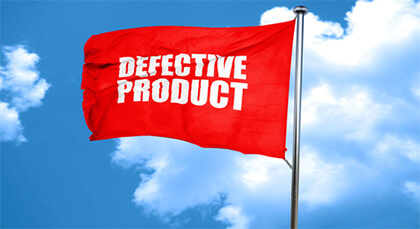As consumers, we trust that the products we buy and not unsafe or defective.
In fact, whether or not a product will be safe to use, is a consideration that most consumers give little to no thought. This stems from the high standards of product safety that we have come to expect here in Australia. When purchasing a product, particularly if it is Australian made, we expect that the safety standards are maintained and even exceeded. The truth is, that no matter how careful and thorough manufacturers are, defects and safety issues still arise.
With this in mind, some Australians are unfortunate enough to suffer some considerable injuries and losses as a result of defective products, or products being unsafe for the purpose for which they were bought.
The Australian Consumer Law
The Australian Consumer Law (or sometimes known as the ACL) is the body of law that provides for fair trading and consumer protection in Australia.
The Australian Consumer Law contains provisions that protect consumers from various types of unlawful conduct. It grants consumers a series of consumer protections that make it illegal for business providing good or services, to unethically take advantage of consumers.
Some of the things that the Australian Consumer Law protects consumers from include:
- Misleading or deceptive conduct;
- Unconscionable conduct;
- Unfair contract terms;
- Unfair practices;
- Unfair consumer transactions (for example, unfair conditions and warranties);
- Unsafe consumer goods and product related services; and,
- Goods with safety defects.
Unsafe and Defective Products
Section 138 is the relevant section in the Australian Consumer Law that gives consumers the right to claim compensation against a manufacturer when they produce goods with safety defects. Section 138(1) and (2) of the Australian Consumer Law outlines:
“(1) A manufacturer of goods is liable to compensate an individual if:
(a) the manufacturer supplies the goods in trade or commerce; and
(b) the goods have a safety defect; and
(c) the individual suffers injuries because of the safety defect.
(2) The individual may recover, by action against the manufacturer, the amount of the loss or damage suffered by the individual…”
This section makes a manufacturer liable for injuries that individual may suffer if a product that has a safety defect injures them. In this case the manufacturer will be liable to compensate the individual for the amount of loss suffered as a result of the injuries.
A consumer’s right to pursue compensation under Section 138 of the Australian Consumer Law, has a number of different elements that needs to be considered. Some of these include:
- What is a safety defect?
- What needs to be proven?
- Any exceptions which exist.
What is a “safety defect”?
Section 9 of the Australian Consumer Law provides us with the meaning of a unsafe or defective products.
Section 9(1) provides that goods have a safety defect if their safety is not such as persons generally are entitled to expect. This takes into account all the relevant individual circumstances that might surround an incident. Section 9(2) allows the Court to take into account things such as the product’s purpose, how it was packaged, any instructions or warnings on the product and whether the product was used reasonably.
What needs to be proven?
To successfully prove that a safety defect has unfairly caused a consumer to be injured or suffer loss, a few things are required to in order to hold a manufacturer liable.
A person bringing a claim against a manufacturer must prove that there is a defect in the goods used and the fact that an injury or loss has occurred. Once these elements have been established, it must be shown that there is casual connection between the safety defect in the goods and the injury or loss suffered.
It is also important to note that to bring a claim of compensation under Section 138, it is not enough that a product is merely defective. Rather the use of the product must have caused an individual to suffer injury, loss or damage because of the safety defect.
Exceptions
Despite the above, there are a handful of exceptions that a manufacturer can rely on to avoid liability in these situations. A manufacturer will not be held liable for an injury or loss suffered by an individual if:
- the safety defect did not exist when the goods were supplied;
- the safety defect occurred because of compliance with a mandatory standard;
- the safety defect could have in no way been discovered;
- the safety defect is attributable to a component in the defective goods, and the defect is only attributable to the design of the component, the markings on them or the instructions given with them.
If you or somebody that you know has suffered loss or injury while using an unsafe or defective product, you may be entitled to compensation. For more information, and to arrange a free, no-obligation assessment of your claim, please call Stacks Goudkamp on 1800 251 800, or alternatively make an online enquiry.
APPEAL
On appeal, the insurer did not dispute that it was not entitled to withdraw the admission of liability that it made pursuant to s81. It contended, however, that it was nonetheless entitled to decline to indemnify the insured in respect of any liability arising from the claim made by the claimant, and that it was entitled to a certificate of exemption under s92(1)(a) pursuant to cl 8.11.5.
In a majority judgment by Beazley PA and Ward JA, the New South Wales Court of Appeal held that a s81 Notice admitting liability is not binding for all purposes. The insurer continues, after giving notice admitting liability under s81, to have an entitlement to deny indemnity to an insured.
In dissent, Simpson JA said:
As delegated legislation, the Guidelines must be read consistently with the Act. Since the language of s81(1) does not admit of an interpretation whereby an insurer can admit liability for the claim but not indemnify the insured, neither can sub-cl 8.11…
The exclusion of the insured… from involvement in the resolution of the claim has the consequence that once an insurer has admitted liability for a claim it cannot be given exemption from the assessment process by reason of sub-cl 8.11.5 of the Guidelines.
CONCLUSION
Mr Mordue filed an Application for Special Leave to the High Court of Australia. However, the matter settled satisfactorily before the Application was heard by the Court.
It therefore remains that an insurer cannot withdraw an admission of liability once it has been made; however, the notice admitting liability under s81 is not binding for all purposes, namely, an insurer continues to have an entitlement to deny indemnity to an insured.



